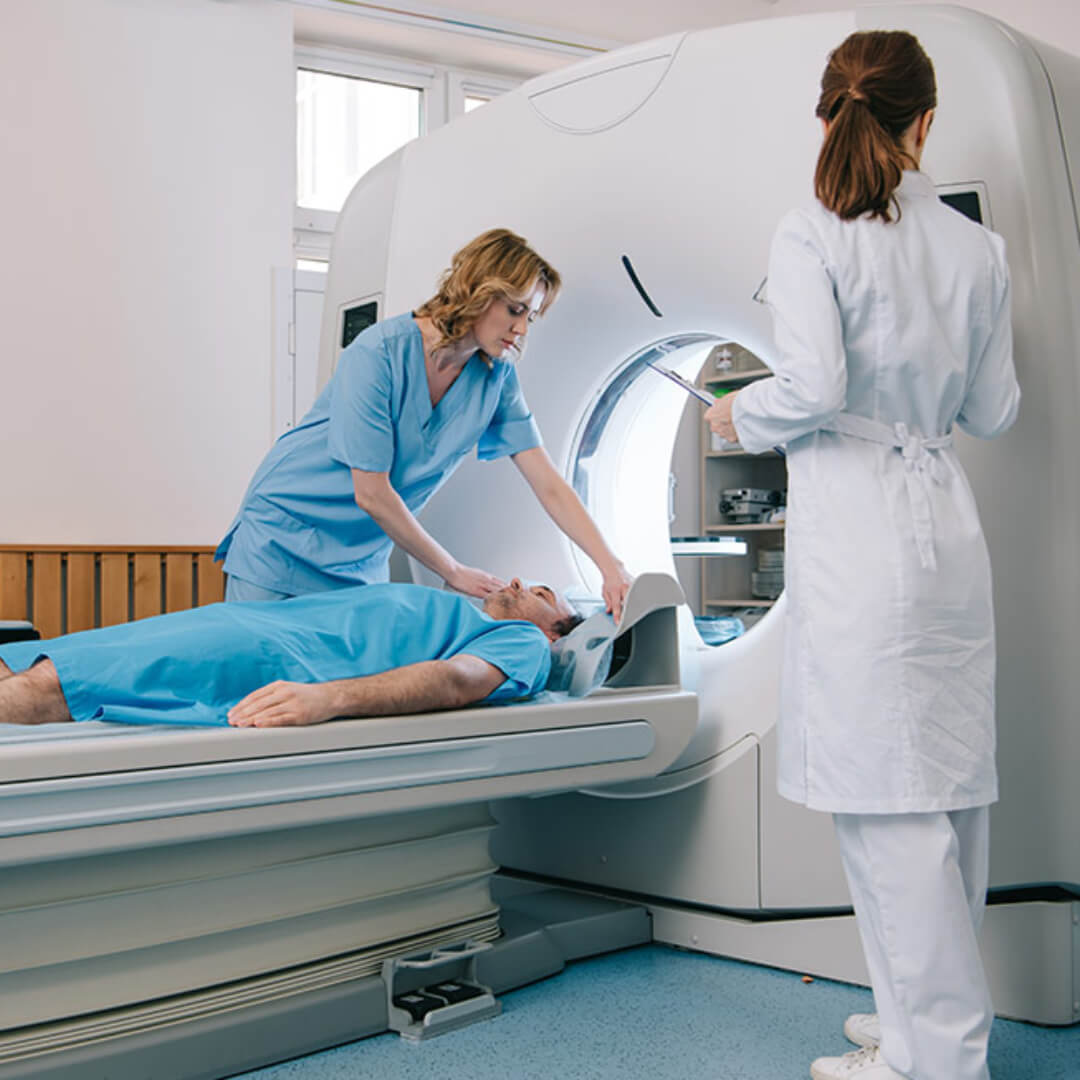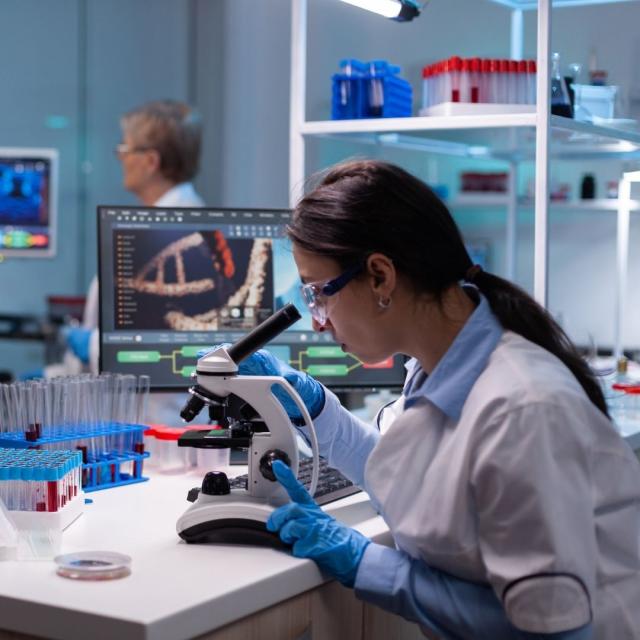If you are interested in producing high-quality medical images using advanced technical equipment, working with a collaborative team of medical professionals and communicating with patients of all ages, a career in radiography could be a good fit for you.
Radiographers play a vital role in modern healthcare, combining advanced imaging technology with patient-centred care.
As a radiographer, you will be at the forefront of diagnostic medicine, producing high-quality images that are essential for accurate diagnosis and effective treatment planning.
There are currently 18,976 medical radiation practitioners in Australia and this number is projected to increase by 14.7 per cent over the next five years.
This article will delve into the world of radiography and explore everything from roles and responsibilities to how much radiographers earn, educational requirements and more.
What is a radiographer?
Radiographers are responsible for operating imaging equipment such as X-ray machines, computed tomography (CT) scanners and magnetic resonance imaging (MRI) scanners. This equipment is used to capture detailed medical images of patients that help medical professionals detect physiological and metabolic changes within the body, assess soft tissue abnormalities and monitor the progression of diseases such as cancer.
These professionals also play a hands-on role in patient care, working directly with patients, physicians and other healthcare professionals. They typically work in public and private hospitals, specialised clinics and private practices.
A common misconception is that radiographers and radiologists perform the same role. While they are closely related, they have distinct responsibilities in the diagnostic imaging process.
While radiographers are responsible for capturing high-quality images safely and efficiently, radiologists interpret these images, analyse the findings and provide diagnostic reports that guide treatment plans.
What does a radiographer do?
The roles and responsibilities of a radiographer may differ depending on their specialisation and work environment.
For instance, a radiographer working in a private hospital may be assigned to various departments such as the emergency room, operating room or critical care units based on the hospital’s needs. Additionally, they would work with a diverse range of patients from walk-in outpatients to those in critical trauma situations.
In contrast, a radiographer working in an outpatient clinic would typically focus on routine non-urgent cases, managing scheduled appointments and conducting standard imaging procedures.
The primary roles and responsibilities of a radiographer typically include:
- Operating imaging equipment: Safely operating X-ray machines, CT and MRI scanners to produce high-quality images.
- Patient care: Explaining what will happen during procedures such as X-rays, MRIs or CT scans and ensuring patients are comfortable, informed and safe throughout the imaging process. Consent is also a vital component of patient care, especially when contrast materials such as gadolinium or iodine-based and barium-sulphate compounds are used to aid in the accuracy of a procedure being performed.
- Collaborating with medical professionals: Working closely with physicians and radiologists to deliver precise images that aid diagnosis and treatment planning.
- Adjusting imaging settings: Monitoring and fine-tuning imaging equipment to optimise image clarity and reduce radiation exposure.
- Reviewing image quality: Assessing the clarity and accuracy of captured images before sending them to radiologists for interpretation.
- Maintaining equipment: Performing routine checks on imaging equipment to ensure reliability and patient safety.
- Maintaining patient records: Keeping detailed records of imaging procedures and relevant medical history to ensure accurate documentation and patient care.
Radiographers at private practices typically work about 38 hours a week full time. However, those working in hospitals may have longer hours and shifts which include early mornings and late nights.
How much do radiographers earn in Australia?
Radiographers have competitive salaries which vary based on experience, geographical location and specialisation.
For example, those who pursue additional training in areas like MRI, CT or mammography often earn higher wages.
Location also plays a part. Below is a list of average salaries for select state and territories from lowest to highest:
- Australian Capital Territory: $84,999
- South Australia: $91,250
- New South Wales: $91,671
- Tasmania: $95,000
- Victoria: $97,500
- Northern Territories: $97,500
- Queensland: $100,000
- Western Australia: $102,500
Average radiographer salary in Australia
Radiographer jobs are advertised on job platforms such as SEEK, Indeed and LinkedIn. On average, the annual salary for a radiographer ranges from $85,000 to $105,000 per annum.
With experience, radiographers can advance to supervisory, management or research roles and contribute to developments in imaging technology. These career advancements often come with increased earning potential as well.
5 steps to becoming a radiographer in Australia
-
Consider whether this is the right career path for you
A career in radiography requires more than just technical expertise. It also requires strong communication skills, attention to detail and a patient-centred approach.Although radiographers are not medical doctors, they are still responsible for understanding the body’s structure and how injury or disease affects patients.
If you find fulfilment working independently and collaborating with a team of healthcare professionals, radiography offers the opportunity to play a vital role in patient care.
-
Get a relevant degree
To become a radiographer in Australia, students typically complete a bachelor’s degree in medical radiation science, medical imaging or a similar field.The degree usually involves four years of full-time study and includes at least 40 weeks of clinical placements. Placements can be completed in metro, regional or interstate areas. Some universities also offer overseas placement opportunities.
These placements begin in the first year and are designed to provide real-world experience in medical imaging and diagnostic techniques such as X-rays, CT and MRI scanning.
If you already hold a bachelor’s degree in radiography and wish to develop new skills or advance your career or if you have a degree in another field and are looking to change careers, you may be eligible to apply for a Master of Medical Imaging or an equivalent qualification which typically involves two years of full time study.
These programs require at least 20 weeks of clinical placements and delves into areas such as advanced diagnostic radiography techniques, emerging technologies, leadership skills and research methods.
For individuals who already have a degree in radiography or relevant experience, advanced master’s courses are available. These programs focus on research, clinical leadership and critical thinking, providing opportunities for career advancement and specialisation.
Here is a table to summarise the above. Please note that specific requirements may vary between universities.
Program Duration Who is it suitable for? Core content Clinical placement Admission requirements Bachelor of Radiography (or similar) 4 years full-time Individuals that are new to and interested in pursuing a radiography career. Anatomy and the knowledge and skills to produce high-quality medical images. 40+ weeks starting from the first year. A minimum ATAR and a minimum score in an English, maths and science unit. Master of Medical Imaging (or similar) 2 years full-time Individuals with a bachelor’s degree in a different field looking to pursue a radiography career or individuals that already hold a bachelor’s degree in radiography and wish to develop new skills or advance their career. Advanced diagnostic radiography techniques, emerging technologies, leadership skills and research methods. 20+ weeks starting from the first year. Bachelor’s degree with a minimum weighted average mark. Some universities also specify that the degree should be in science or health science. Master of Advanced Medical Radiation Practice (or similar) 1.5 years full time Experienced radiographers or those with a radiographer degree. Research, clinical leadership, advanced imaging techniques. Specialised placements or research-based projects. Current registration with the MRPBA, a degree in radiography or similar or clinical experience. - Register with the Australian Health Practitioner Regulation Agency (AHPRA)
Upon completing your degree, you must register with AHPRA under the MRPBA to practise legally as a radiographer. -
Obtain a radiation use licence
In addition to MRPBA registration, you must obtain a radiation use licence from your state or territory’s radiation regulatory authority.This licence authorises you to operate radiation-emitting equipment and ensures that you comply with safety standards.
-
Start applying for jobs
Qualified radiologists can apply for positions via SEEK, Indeed, LinkedIn and other job boards. You will have the opportunity to work in both public and private hospitals, specialist clinics and private medical centres.Through networking and gaining experience within the field, you can also explore additional career paths and opportunities for specialisation in areas such as MRI, CT or radiation therapy planning, treatment and patient care.
Begin your career in radiography
A career in radiography is both professionally and personally rewarding. Radiographers work closely with patients from diverse backgrounds and play an integral role in healthcare by using advanced imaging technology to capture high-quality images vital for diagnosis and treatment.
By completing the necessary education, gaining hands-on experience and pursuing career opportunities, you can embark on a rewarding career in this field and ensure that healthcare providers have the detailed imaging required to make informed decisions about patient health.
As you consider your path in healthcare, remember that the medical field offers a range of other rewarding careers in areas such as counselling, leadership and management, mental health, nursing, psychology, social work and public health.
If you would like to pursue education in any of these disciplines, explore the courses available from our university partners on GlobalHealth Education.


















